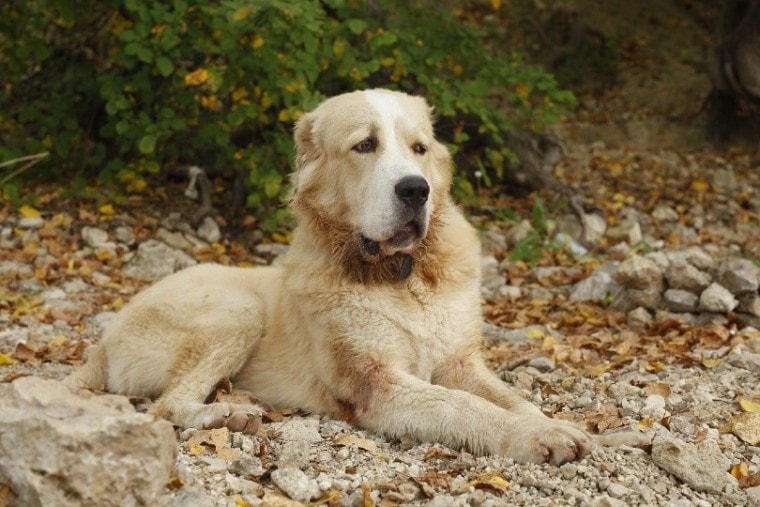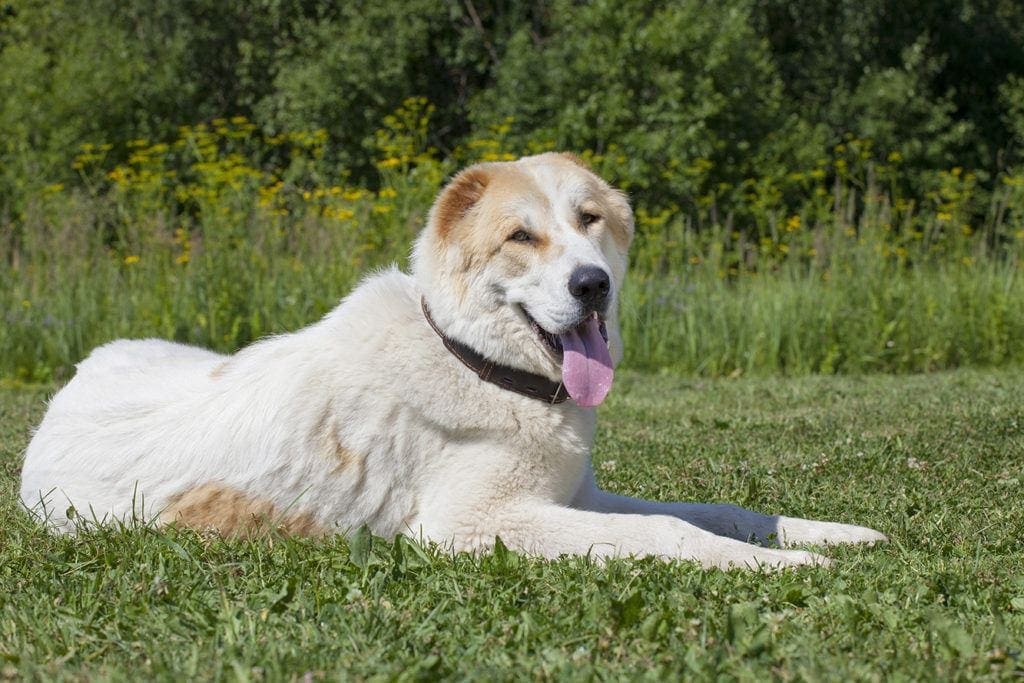
Click Below to Skip Ahead
The Central Asian Shepherd Dog is also known as the Alabai, the Mid-Asian Ovtcharka, and the Middle Asian Ovtcharka. These dogs have been bred to work alongside humans for over 5,000 years! Not for the apartment dweller, these dogs need to be outside and have a task to complete.
Breed Overview
Height:
25.5 – 27.5 inches
Weight:
112 – 170 pounds
Lifespan:
12 – 15 years
Colors:
Brindle, white, fawn, black
Suitable for:
Families, cold climates, rural areas
Temperament:
Territorial, confident, quiet, affectionate with its family
They are good family dogs for farming families or those with a large, securely fenced yard. They are strong, brave, and protective. If you are an experienced dog owner looking for a hard-working companion for your family, read more to learn about these great dogs!
Central Asian Shepherd Characteristics
 Central Asian Shepherd Dog Puppies
Central Asian Shepherd Dog Puppies

Central Asian Shepherd Dogs have few breeders in the United States. As a result, they are fairly rare and quite expensive. You should always do your homework when buying a puppy from a breeder. Don’t be afraid to ask questions about the breeder’s experience, the puppy’s parents, and any other information you want before taking your puppy home.
It is also important to keep in mind that the cost of the puppy does not take into account the cost of keeping the dog healthy and happy. These are very large dogs who need plenty of food which you also need to account for when working out your budget. They will also require training and a place to roam around.
As they are not as common in the United States, you may have a difficult time finding a Central Asian Shepherd in a shelter. There are also currently no breed-specific rescues for these dogs.

Temperament & Intelligence of the Central Asian Shepherd Dog
The Central Asian Shepherd Dog is known for its high level of intelligence, paired with a fiercely independent streak. This can make them difficult to train. They are certainly capable of learning, it’s just a matter of breaking through that stubbornness. Because of this, it is not recommended that an inexperienced dog owner works with a Central Asian Shepherd. An experienced owner, or even better, an experienced trainer will benefit both the dog and its family.
Are These Dogs Good for Families? 👪
Yes, the Central Asian Shepherd makes a good family pet for the right family. They are very protective of their families and like to play with respectful children. They tend to be wary of strangers, although they are affectionate with their families. This makes them excellent guard dogs.
It is important to keep in mind that these are large dogs who need space to roam. They are not for an apartment-dwelling family. However, if you have a large, securely fenced yard or, even better, live in a rural area with plenty of land, your dog will thrive.
Does This Breed Get Along with Other Pets?
Yes, generally the Central Asian Shepherd gets along fine with other pets. It is important to socialize them from a young age, as is true of all dogs. However, as long as they have been properly introduced, these dogs can live with cats and other dogs with no problems.
It is also said that the Central Asian Shepherd Dog thrives in the company of other Central Asian Shepherds.

 Things to Know When Owning a Central Asian Shepherd Dog
Things to Know When Owning a Central Asian Shepherd Dog
All dogs have specific needs that need to be met for them to live their healthiest and happiest lives. The Central Asian Shepherd is the same. Their size, temperament, energy level, and grooming requirements shape their needs. You must do your homework before bringing one of these dogs into your home.
Food & Diet Requirements 🦴
The Central Asian Shepherd is a very large dog, so it needs high-quality dog food formulated for large or extra-large breeds. When they are puppies, these dogs grow very quickly so they need food that helps their bones and joints develop properly. This will help prevent long-term health problems.
Once they reach approximately 18 months of age, they should be finished growing. At this time, you will want to monitor their weight, food intake, and treats. Most dogs of this size require about 4 cups of food per day, although this will vary depending on activity level, size, and nutritional needs. The Central Asian Shepherd can be prone to weight gain if they are overfed or under-exercised. An overweight large dog is more susceptible to hip dysplasia and other issues.
Exercise 🐕
The Central Asian Shepherd is a large dog with great endurance. However, they are not especially energetic. To prevent weight gain, you need to make sure that your dog gets plenty of exercise each day. At least an hour is recommended. Activities like long walks, hikes, or farm work suit them well. They also like to roam your property to keep it clear of intruders, predators, or other nuisances.

Training 🎾
Even though Central Asian Shepherds are very intelligent, they are notoriously difficult to train. Their stubborn and independent nature requires a firm, consistent trainer who is willing to put in the work necessary to bring out the best in their dog. With the right owner, these dogs can be trained to follow many commands. Reward-based training works best, as they do not respond well to harsh training.
Grooming ✂️
Central Asian Shepherds have thick, dense coats that require weekly brushing. During shedding season, they will shed quite a bit so more frequent brushing will be needed. Outside of brushing, they are fairly low maintenance. You should cut their nails about twice per month and brush their teeth daily. Occasional baths will keep doggy odors at bay.
Health and Conditions 🏥
Considering the size of the breed, the Central Asian Shepherd is a remarkably healthy dog. They do not tend to suffer from many of the other genetic health conditions that plague larger dogs. Keeping your dog at a healthy weight will help ensure that your specific dog is as healthy as the rest of the breed.
Minor Condition:
Dental diseases can occur if your dog’s teeth are not cleaned frequently. Be sure to discuss proper brushing techniques with your veterinarian to ensure you are cleaning them correctly.
Serious Condition:
The only serious condition Central Asian Shepherds are prone to have is hip and elbow dysplasia. This condition is common in large breed dogs and can be debilitating. Hip and elbow dysplasia occurs when the joints don’t properly fit into their sockets. This can cause pain and discomfort for your dog. As it progresses, the condition may require surgery to maintain your dog’s quality of life.
Male vs Female
The biggest difference between male and female Central Asian Shepherds is in their size. Males are usually larger, standing about 1 to 2 inches taller than females. They are also heavier with some males reaching 170 pounds when fully grown.
There is no discernable difference in temperament between the male and female Central Asian Shepherd.
3 Little-Known Facts About the Central Asian Shepherd
1. They Have Been Around a Long Time!
The Central Asian Shepherd Dog is believed to be the longest known surviving breed. They have been documented in Central Asia for over 5,000 years. Some believe they have been around for even longer than that!
2. Central Asian Shepherd Dogs Appreciate Quiet Time
These dogs are used to working and playing outside and then settling down once they are indoors. They are generally very calm and quiet when they are inside.
3. Cold Weather Doesn’t Bother Them
Since they come from a region with harsh winters, the Central Asian Shepherd Dog is not one to be bothered by the cold. They develop a thick undercoat that keeps them warm, even when the temperatures dip below freezing.
Final Thoughts
The Central Asian Shepherd is a wonderful family dog for the active, rural-dwelling family. They are great guardians of your property, home, and children but they also know how to settle down and relax quietly indoors.
While they are not for the novice dog owner, an experienced dog owner will be able to bring out the best in this breed. If you are willing to commit the time, patience, and energy to train your Central Asian Shepherd, you will be rewarded with a devoted companion.
If this sounds like you, then you may want to consider a Central Asian Shepherd for your next family pet.
Featured Image Credit: shelma25, Pixabay

 Central Asian Shepherd Dog Puppies
Central Asian Shepherd Dog Puppies Things to Know When Owning a Central Asian Shepherd Dog
Things to Know When Owning a Central Asian Shepherd Dog




